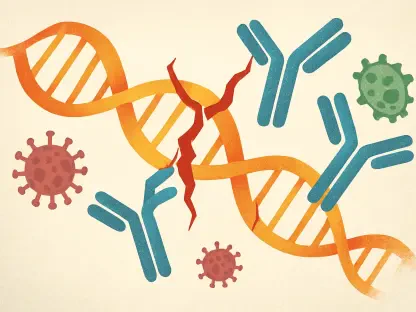What if the natural process of growing older silently fueled a fatal condition that steals breath from thousands each year, revealing a hidden threat in the aging process? Idiopathic pulmonary fibrosis (IPF), a progressive lung disease that scars the lungs of older adults, has emerged as a critical health challenge, often leaving patients with just a few years to live after diagnosis. With artificial intelligence (AI) now stepping into the spotlight, researchers are uncovering startling connections between aging and this devastating illness, offering a glimmer of hope for new treatments. This exploration into the intersection of technology and biology promises to reshape how age-related diseases are understood and fought.
The Weight of a Silent Epidemic
IPF strikes predominantly those over 60, weaving a deadly web of scar tissue through the lungs that makes every breath a struggle. The disease’s grim reality—a median survival of just 3 to 5 years post-diagnosis—underscores a pressing need for answers. As the global population ages, the prevalence of such conditions is set to rise, placing immense strain on healthcare systems worldwide. This growing burden highlights why unraveling the link between aging and IPF isn’t just a scientific pursuit but a societal imperative, with the potential to improve countless lives.
The significance of this issue extends beyond numbers. For every patient grappling with IPF, there’s a family facing the emotional toll of a loved one’s declining health. The urgency to find solutions is palpable, driving scientists to leverage cutting-edge tools like AI to dissect the biological underpinnings of the disease. This story isn’t merely about a medical condition; it’s about redefining how aging impacts health and finding ways to intervene before it’s too late.
AI as a Beacon in Biomedical Discovery
Artificial intelligence has become a game-changer in decoding complex health puzzles, and its role in studying IPF is no exception. By analyzing vast datasets, AI is revealing shared biological pathways between aging and IPF, including critical mechanisms like TGF-β signaling, oxidative stress, inflammation, and extracellular matrix remodeling. These pathways, while overlapping, show distinct gene expressions in IPF compared to normal aging, proving that the disease isn’t just accelerated aging but a unique pathological process.
Two groundbreaking AI tools are at the forefront of this research. A fibrosis-aware aging clock, developed using proteomics data from large biobanks, predicts biological age with remarkable precision, boasting an R² value of 0.84 and a mean error of just 2.68 years. Meanwhile, an omics transformer model known as IPF-Precious3GPT dives into gene expression patterns, identifying both common and divergent signatures in aging and diseased lungs. These tools are not just mapping biology; they’re setting the stage for transformative medical breakthroughs.
A striking finding from this technology is the link between disease severity and accelerated aging. Patients with severe infections prone to lung fibrosis exhibit biological ages far exceeding their chronological years, as revealed by the aging clock. This suggests a vicious cycle where IPF progression may intensify cellular aging, opening new avenues for early detection and intervention strategies that could halt the disease in its tracks.
Expert Perspectives Driving Progress
The credibility of these discoveries is reinforced by leaders in AI-driven biotechnology. Dr. Alex Zhavoronkov, a prominent figure in the field, has noted, “AI isn’t just a tool for understanding biology; it’s a catalyst for faster, more targeted drug discovery in diseases like IPF.” His insights reflect a broader consensus among scientists that technology can turn complex data into actionable solutions, a belief backed by the aging clock’s ability to highlight discrepancies between biological and actual age in fibrotic patients.
This expert viewpoint aligns with tangible outcomes. The application of AI models has shown that patients with advanced IPF often register as biologically older, a finding that resonates with clinical observations of rapid health decline in such cases. This intersection of data and expertise underscores a pivotal shift in research, where technology bridges the gap between theoretical biology and real-world health challenges, paving the way for innovative approaches.
The momentum behind these efforts is evident in the scientific community’s growing reliance on AI to tackle age-related conditions. With over 200 peer-reviewed studies supporting the use of such technologies, there’s a clear recognition that these tools are not a passing trend but a cornerstone of future medical advancements. This collective confidence fuels optimism for what lies ahead in the battle against IPF.
Turning Insights into Action
The practical implications of AI-driven research are vast, offering a roadmap for tangible impact on IPF management. One key application is early diagnosis, where the fibrosis-aware aging clock can identify at-risk individuals by detecting signs of accelerated biological aging long before symptoms manifest. Such early warnings could enable interventions that prevent irreversible lung damage, changing the trajectory for many patients.
Another promising direction is targeted drug development, focusing on the four shared pathways identified through AI analysis. By honing in on specific gene expressions unique to IPF, researchers can design therapies that avoid generic approaches, instead addressing the disease’s distinct mechanisms. This precision could lead to more effective treatments, reducing side effects and improving patient outcomes in a shorter timeframe.
Personalized medicine also stands to benefit, with tools like IPF-Precious3GPT enabling tailored treatment plans based on individual biological profiles. This shift toward customization, supported by frameworks that cut preclinical drug development timelines from years to just 12 to 18 months, represents a leap forward in efficiency. For patients, this means faster access to therapies designed specifically for their needs, a development that could redefine standards of care.
Reflecting on a Path Forward
Looking back, the journey to uncover the ties between aging and IPF through AI marked a turning point in medical research. The insights gained illuminated not just the biology of a deadly disease but also the power of technology to address some of humanity’s most pressing health challenges. Each discovery, from shared pathways to accelerated aging markers, built a foundation for hope in a field often shadowed by despair.
The next steps were clear as researchers turned their focus to validating these AI models with larger patient groups, ensuring their findings could apply broadly. Efforts also shifted toward expanding this approach to other age-related and fibrotic conditions, with the aim of creating a scalable framework for chronic disease management. The vision was to integrate these tools into clinical settings, making early detection and personalized care a reality for all.
Beyond the lab, there was a growing call to prioritize funding and collaboration to accelerate these advancements. By fostering partnerships between technologists, clinicians, and policymakers, the potential to transform patient outcomes became tangible. This collective push promised not just to extend lives but to enhance their quality, ensuring that aging no longer carried the hidden threat of diseases like IPF.









